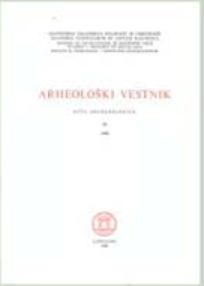Roman Tile-stamps from the Collection in the Marine Museum “Sergej Mašera” in Piran
Abstract
Among the archaeological material in Piran museum there are also several bricks with stamped impressions from Roman brickyards. They come from thirteen different yards. The bricks were discovered in the foundations of the partly excavated Roman villa rustica at Grubelce, at the canalisation of the river Dragonja at Mlini near the village of Dragonja, at Kaštelir near Dvori above Izola, and at Padna and Predloka near Črni Kal. The majority of the stamps preserved in the museum were identified with the help of the most complete collection to date of stamps from Istria and Aquileia and its surroundings, published by C. Gregorutti in two articles. In the ruins of the only partly excavated villa at Grubelce near Sečovlje a brick was found bearing the stamp Q(uinti) dodi Ambrosi (pl. I, fig. 1), inventory no. 710 as well as two other fragments of this stamp (inv. no. 796, 799). The following stamps were also found : [C(ui) Pe]troni Apri (Caiae) Epidi(ae) Av(itiana) (pl. I, fig. 2), inv. no. 708; Valeriae Magn[ae Epidifana) Avijtiana)] (pl. I, fig. 3), inv. no. 645; Terentior (pl. I, fig. 10), inv. no. 804; [L(uci) Epidi Th\eodori (pl. I, fig. 4), Sex(ti) Hei Acuti (pl. I, fig. 14), inv. no. 801. The stamp P(ubli) Ituri Sab(ini), which was found relatively frequently in Istria and the surroundings of Trieste, is partly preserved on fragments from Grubelce, (pl. I, fig. 5), inv. no. 800, at Mlini near the village of Dragonja (pl. I, fig. 6), inv. no. 26, 31, at Padna, inv. no. 80 and at Kaštelir near Dvori above Izola, inv. no. 264. The stamp L(uci) Q(uinti) Thal(us) (pl. I, fig. 9), inv. no. 33 is from Mlini near Dragonja; Crispinillae is found on the fragment of a tegula from Grubelce (pl. I, fig. 12), inv. no. 798 and on three fragments from Mlini near Dragona, inv. no. 25, 30, 34. The poorly preserved stamps on pi. fig. 7, 8, 11, inv. no. 802, 803, 806 from Grubelce and the stamp C(aius) Avet(ius) N(iger) (pl. I, fig. 13), inv. no. 19, 32 from Mlini are not found in Gregorutti’s collection. The range of stamps is obviously a wide one, and if we accept Gregorutti’s scheme of dating stamps from the Aquileian brick — yards, we can place them within a period from the beginning of the first to the end of the second centuries A. D. As our examples show, Gregorutti’s collection can no longer be regarded as complete, although it still remains the most extensive work in existence. Since the publication of this material, new stamps, unknown to Gregorutti, have undoubtedly been discovered in Istria and Aquileia. There is also insufficient foundation for Gregorutti’s opinion that Aquileia was the centre of the brick industry, from where bricks were transported by sea to coastal regions, including Istria. It must be remembered that in Roman times brick was a very common building material in Istria as is indicated by finds, and that especially northern Istria had sufficient raw materials available for making bricks, so that there are grounds for looking for at least a small brickyard there. As yet there are no proofs in support of this theory, but the finds at Viližan, about 1.5 km east of Izola, are most interesting in this connection. A. Degrassi discovered the foundations of a Roman harbour, and beside the modern brickyard which was in the immediate vicinity of the harbour he found extensive walls and a brick canal. In 1954/55 brick walls, ellipsoid in shape, were also discovered in the brickyard itself. There is still too little attention devoted to the stamps on Roman bricks, because a good knowledge of this material could be instrumental in the dating of buildings, as specialists in Roman architecture are realizing.4 The over-superficial knowledge of Istrian and Aquileian stamps also calls for a new and more complete collection and a more thorough study of them. For more successful results, collaboration between researchers into this material in the various countries with a common interest in Roman history would also be desirable.
Downloads
Downloads
Published
How to Cite
Issue
Section
License

This work is licensed under a Creative Commons Attribution-NonCommercial-ShareAlike 4.0 International License.
Authors guarantee that the work is their own original creation and does not infringe any statutory or common-law copyright or any proprietary right of any third party. In case of claims by third parties, authors commit their self to defend the interests of the publisher, and shall cover any potential costs.
More in: Submission chapter





